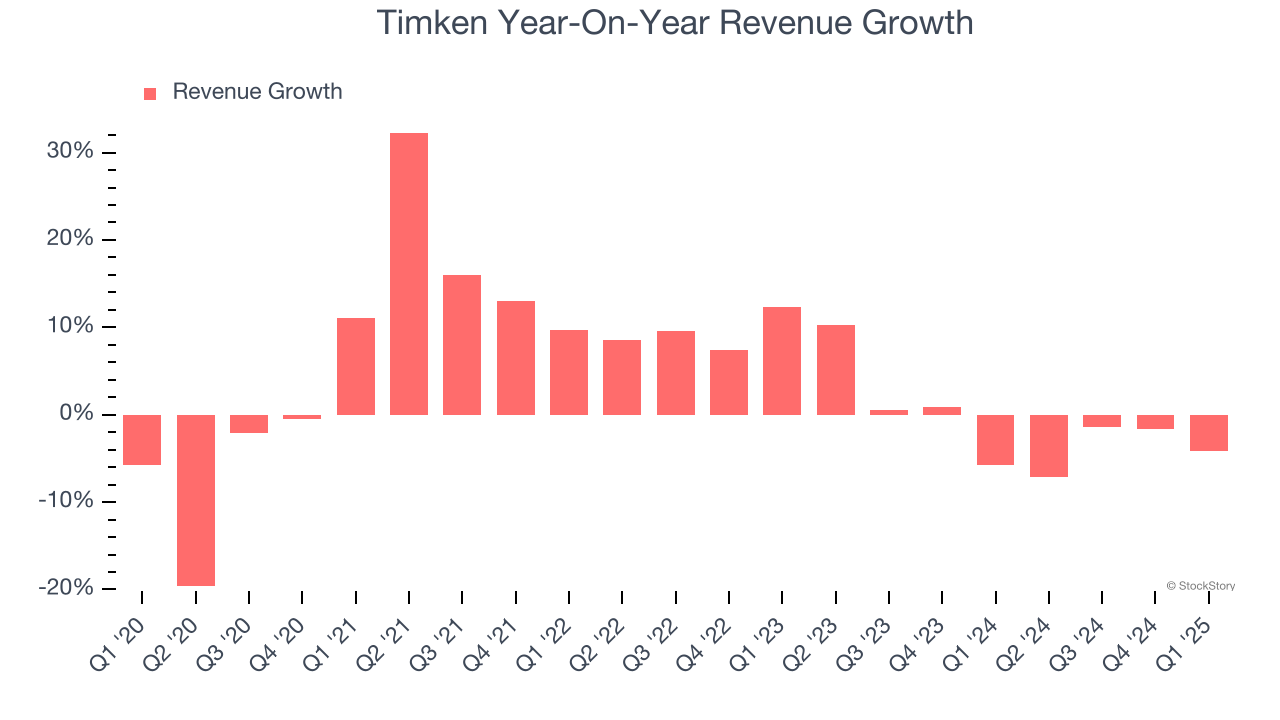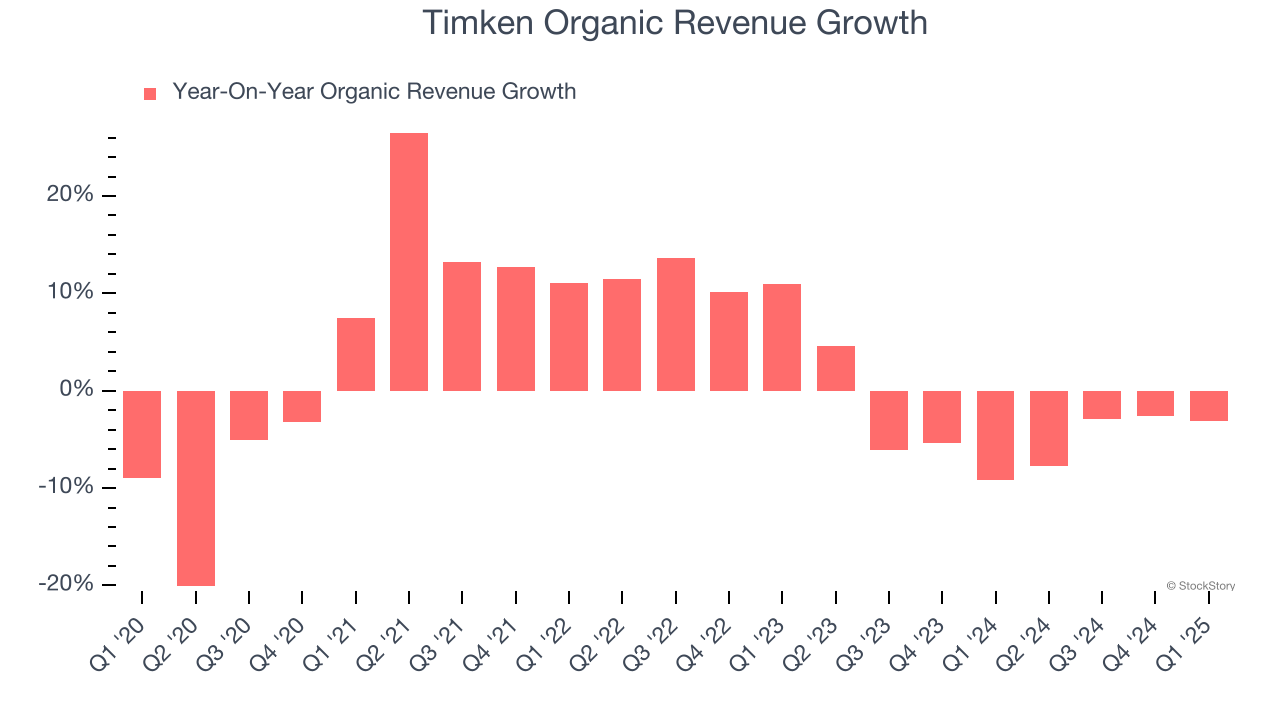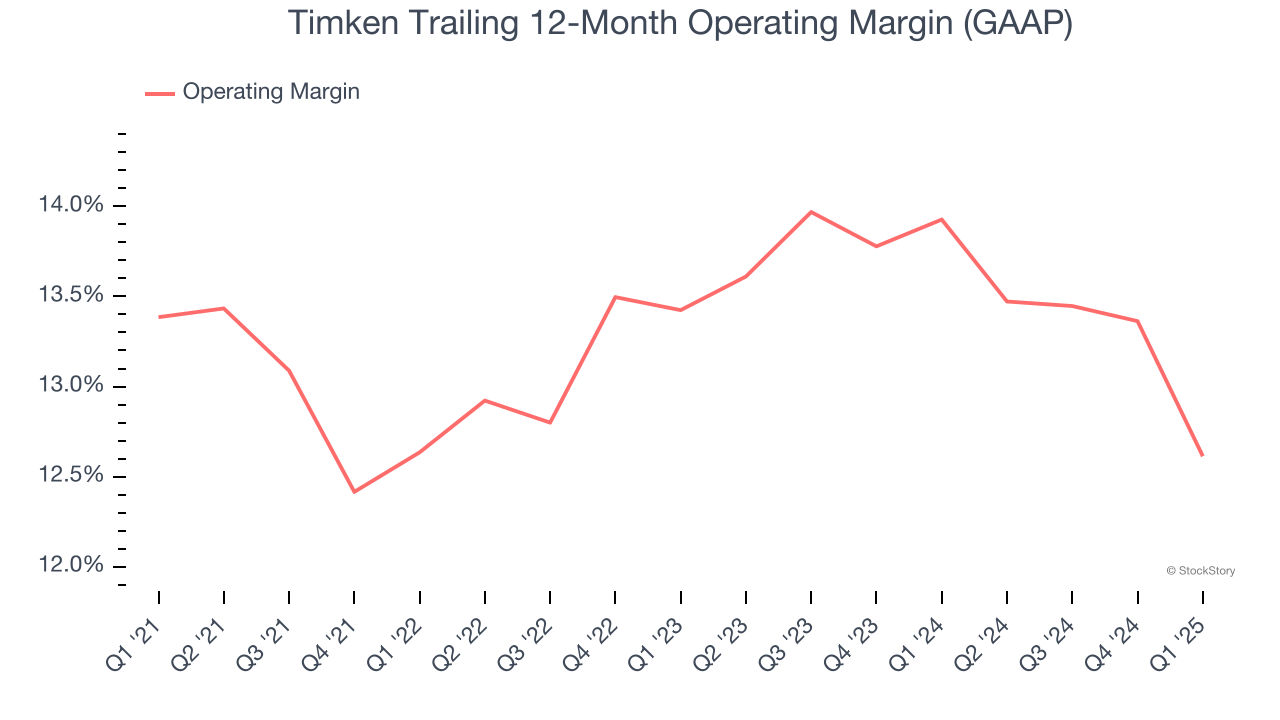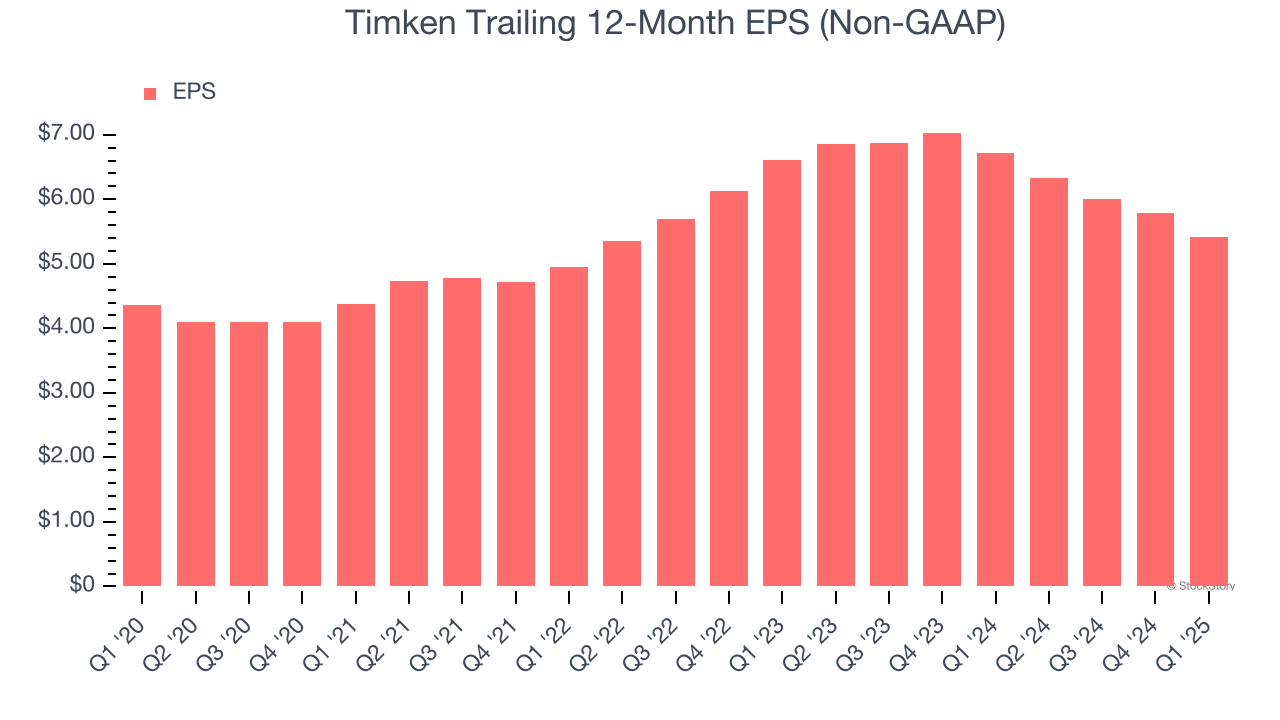
Industrial component provider Timken (NYSE:TKR) reported revenue ahead of Wall Street’s expectations in Q1 CY2025, but sales fell by 4.2% year on year to $1.14 billion. Its non-GAAP profit of $1.40 per share was 1.5% below analysts’ consensus estimates.
Is now the time to buy Timken? Find out by accessing our full research report, it’s free.
Timken (TKR) Q1 CY2025 Highlights:
- Revenue: $1.14 billion vs analyst estimates of $1.13 billion (4.2% year-on-year decline, 1.1% beat)
- Adjusted EPS: $1.40 vs analyst expectations of $1.42 (1.5% miss)
- Adjusted EBITDA: $208.1 million vs analyst estimates of $211.7 million (18.2% margin, 1.7% miss)
- Management lowered its full-year Adjusted EPS guidance to $5.35 at the midpoint, a 3.6% decrease
- Operating Margin: 12.6%, down from 15.5% in the same quarter last year
- Free Cash Flow Margin: 2.1%, up from 0.4% in the same quarter last year
- Organic Revenue fell 3.1% year on year (-9.2% in the same quarter last year)
- Market Capitalization: $4.58 billion
"Timken posted solid first-quarter results in a time of heightened uncertainty," said Richard G. Kyle, president and chief executive officer.
Company Overview
Established after the founder noticed the difficulty freight wagons had making sharp turns, Timken (NYSE:TKR) is a provider of industrial parts used across various sectors.
Sales Growth
Examining a company’s long-term performance can provide clues about its quality. Any business can put up a good quarter or two, but many enduring ones grow for years. Over the last five years, Timken grew its sales at a sluggish 3.9% compounded annual growth rate. This fell short of our benchmark for the industrials sector and is a poor baseline for our analysis.

Long-term growth is the most important, but within industrials, a half-decade historical view may miss new industry trends or demand cycles. Timken’s performance shows it grew in the past but relinquished its gains over the last two years, as its revenue fell by 1.2% annually. 
We can better understand the company’s sales dynamics by analyzing its organic revenue, which strips out one-time events like acquisitions and currency fluctuations that don’t accurately reflect its fundamentals. Over the last two years, Timken’s organic revenue averaged 4% year-on-year declines. Because this number is lower than its normal revenue growth, we can see that some mixture of acquisitions and foreign exchange rates boosted its headline results. 
This quarter, Timken’s revenue fell by 4.2% year on year to $1.14 billion but beat Wall Street’s estimates by 1.1%.
Looking ahead, sell-side analysts expect revenue to decline by 1.1% over the next 12 months, similar to its two-year rate. This projection is underwhelming and suggests its newer products and services will not lead to better top-line performance yet.
Here at StockStory, we certainly understand the potential of thematic investing. Diverse winners from Microsoft (MSFT) to Alphabet (GOOG), Coca-Cola (KO) to Monster Beverage (MNST) could all have been identified as promising growth stories with a megatrend driving the growth. So, in that spirit, we’ve identified a relatively under-the-radar profitable growth stock benefiting from the rise of AI, available to you FREE via this link.
Operating Margin
Operating margin is an important measure of profitability as it shows the portion of revenue left after accounting for all core expenses – everything from the cost of goods sold to advertising and wages. It’s also useful for comparing profitability across companies with different levels of debt and tax rates because it excludes interest and taxes.
Timken has been an efficient company over the last five years. It was one of the more profitable businesses in the industrials sector, boasting an average operating margin of 13.2%. This result was particularly impressive because of its low gross margin, which is mostly a factor of what it sells and takes huge shifts to move meaningfully. Companies have more control over their operating margins, and it’s a show of well-managed operations if they’re high when gross margins are low.
Analyzing the trend in its profitability, Timken’s operating margin might fluctuated slightly but has generally stayed the same over the last five years. This raises questions about the company’s expense base because its revenue growth should have given it leverage on its fixed costs, resulting in better economies of scale and profitability.

This quarter, Timken generated an operating profit margin of 12.6%, down 2.9 percentage points year on year. Since Timken’s operating margin decreased more than its gross margin, we can assume it was less efficient because expenses such as marketing, R&D, and administrative overhead increased.
Earnings Per Share
We track the long-term change in earnings per share (EPS) for the same reason as long-term revenue growth. Compared to revenue, however, EPS highlights whether a company’s growth is profitable.
Timken’s unimpressive 4.4% annual EPS growth over the last five years aligns with its revenue performance. This tells us it maintained its per-share profitability as it expanded.

Like with revenue, we analyze EPS over a more recent period because it can provide insight into an emerging theme or development for the business.
Timken’s two-year annual EPS declines of 9.5% were bad and lower than its two-year revenue performance.
In Q1, Timken reported EPS at $1.40, down from $1.77 in the same quarter last year. This print slightly missed analysts’ estimates. Over the next 12 months, Wall Street expects Timken’s full-year EPS of $5.41 to grow 4.9%.
Key Takeaways from Timken’s Q1 Results
It was good to see Timken narrowly top analysts’ revenue expectations this quarter. We were also happy its organic revenue narrowly outperformed Wall Street’s estimates. On the other hand, its full-year EPS guidance missed and its EBITDA fell short of Wall Street’s estimates. Overall, this quarter could have been better. The stock traded down 3.2% to $63.17 immediately after reporting.
Timken underperformed this quarter, but does that create an opportunity to invest right now? The latest quarter does matter, but not nearly as much as longer-term fundamentals and valuation, when deciding if the stock is a buy. We cover that in our actionable full research report which you can read here, it’s free.
